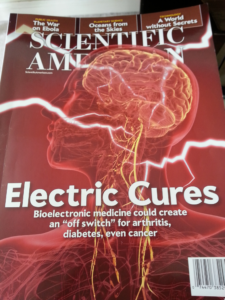
 The following article is a literature review of the use of TAVNS (transcutaneous auricular vagal nerve stimulation) for depression.
The following article is a literature review of the use of TAVNS (transcutaneous auricular vagal nerve stimulation) for depression.
https://www.ncbi.nlm.nih.gov/pubmed/30593183
Transcutaneous auricular vagus nerve stimulation in treating major depressive disorder: A systematic review and meta-analysis.
Abstract
BACKGROUND:
Transcutaneous auricular vagus nerve stimulation (taVNS), as a noninvasive intervention, has beneficial effects on major depressive disorder based on clinical observations. However, the potential benefits and clinical role of taVNS in the treatment of major depressive disorder are still uncertain and have not been systematically evaluated. Therefore, we performed a systematic review and meta-analysis to evaluate the effectiveness and safety of taVNS in treating major depressive disorder.
METHODS:
Four electronic databases, namely, Embase, MEDLINE, the Cochrane Library and PsycINFO, were searched for all related trials published through May 1, 2018. We extracted the basic information and data of the included studies and evaluated the methodological quality with the Cochrane risk of bias tool and the nonrandomized studies-of interventions (ROBINS-I) tool. A meta-analysis of the comparative effects was conducted using the Review Manager 5.3 software.
RESULTS:
A total of 423 citations from the databases were searched, and 4 studies with 222 individuals were included in the meta-analysis. The taVNS technique could decrease 24-item HAMD scores more than the sham intervention (MD: -4.23, 95% CI: -7.15, -1.31; P = .005) and was also more effective in decreasing Self-Rating Depression Scale scores ((MD: -10.34, 95% CI: -13.48, -7.20; P < .00001), Beck Depression Inventory scores (MD: -10.3, 95% CI: -18.1, -2.5; P = .01) and Self-Rating Anxiety Scale scores (MD: -6.57, 95% CI: -9.30, -3.84; P < .00001). However, there was no significant difference in the Hamilton Anxiety Rating Scale scores between the taVNS and sham taVNS groups (MD: -1.12, 95% CI: -2.56, 0.32; P = .13). No obvious adverse effects of taVNS treatment were reported in the included studies.
CONCLUSION:
The results of the analysis preliminarily demonstrated that taVNS therapy can effectively ameliorate the symptoms of major depressive disorder, providing an alternative technique for addressing depression. However, more well-designed RCTs with larger sample sizes and follow-ups are needed in future studies to confirm our findings.

